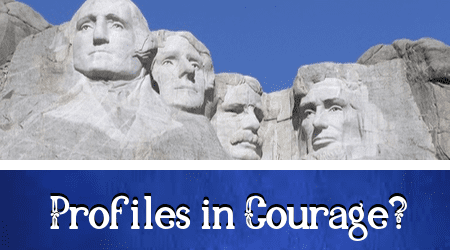-
Founding Presidents (1789-1829)
- George Washington: The Father of the United States – Lesson
- John Adams: A Stubborn but Dedicated Leader – Lesson
- Thomas Jefferson: The Author of Independence – Lesson
- Founding Presidents: Washington, Adams, and Jefferson – Quiz
- James Madison: The Father of the Constitution – Lesson
- James Monroe: Opposing the Federalists – Lesson
- John Quincy Adams: The Federalists who Abandoned the Party – Lesson
- Founding Presidents: Madison, Monroe, and Adams – Quiz
-
Civil War Presidents (1829-1869)
- Andrew Jackson: The First Democrat – Lesson
- Martin Van Buren: The Little Magician – Lesson
- Civil War Presidents: Jackson and Van Buren – Quiz
- William Henry Harrison: The Indian-Fighter – Lesson
- John Tyler: The First President to Not Be Elected – Lesson
- James Polk: Young Hickory – Lesson
- Zachary Taylor: Old Rough and Ready – Lesson
- Millard Fillmore: The Last Whig President – Lesson
- Franklin Pierce: A President Ruined by Slavery – Lesson
- Franklin Pierce: A President Ruined by Slavery – Quiz
- James Buchanan: A President for States’ Rights – Lesson
- James Buchanan: A President for States’ Rights – Quiz
- Abraham Lincoln: The Great Emancipator – Lesson
- Abraham Lincoln: The Great Emancipator – Quiz
- Andrew Johnson: The First President to Be Impeached – Lesson
-
Reconstruction Presidents (1865-1901)
- Ulysses S. Grant: A Friend of Mark Twain – Lesson
- Ulysses S. Grant: A Friend of Mark Twain – Quiz
- Rutherford B. Hayes: The First President to Lose the Popular Vote – Lesson
- Rutherford B. Hayes: The First President to Lose the Popular Vote – Quiz
- James A. Garfield: The Last of the Log Cabin Presidents – Lesson
- James A. Garfield: The Last of the Log Cabin Presidents – Quiz
- Chester A. Arthur: A One Term President – Lesson
- Chester A. Arthur: A One Term President – Quiz
- Grover Cleveland: A President of Principle – Lesson
- Grover Cleveland: A President of Principle – Quiz
- Benjamin Harrison: The Second President in His Family – Lesson
- Benjamin Harrison: The Second President in His Family – Quiz
- William McKinley: The Third Presidential Assassination – Lesson
- William McKinley: The Third Presidential Assassination – Quiz
-
20th Century Presidents
- Richard Nixon: The Only President to Ever Resign – Lesson
- Richard Nixon: The Only President to Ever Resign – Quiz
- Gerald Ford – America’s First Unelected President – Lesson
- Gerald Ford – America’s First Unelected President – Quiz
- Jimmy Carter – the President Who Promised He’d Never Lie – Lesson
- Jimmy Carter – the President Who Promised He’d Never Lie – Quiz
- Ronald Reagan – The ‘Peace Through Strength’ President – Lesson
- Ronald Reagan – The ‘Peace Through Strength’ President – Quiz
Chester A. Arthur: A One Term President – Lesson
Arthur assumed the presidency after Garfield’s assassination – and never ran for re-election.
Chester A. Arthur (1829 – 1886) became the 21st president in 1881. His presidency was short, and many historians say it wasn’t very memorable – though it was still filled with both controversy and accomplishments.
History states he was born on October 5, 1829 in Fairfield, Vermont, however, it was debated – but never proven – that he had actually been born in Canada, which would have made him ineligible to become president of the United States. He was one of only five presidents who reached the office without being elected.
During the Civil War, Arthur served as quartermaster general for the New York state militia. His troubles began when, in 1871, President Ulysses S. Grant appointed him as the collector of the Port of New York.
 He was a good friend of New York Senator Roscoe Conkling, and the two reportedly used their powers to get kickbacks from employees at the port. The money then went to Conkling’s political party funds.
He was a good friend of New York Senator Roscoe Conkling, and the two reportedly used their powers to get kickbacks from employees at the port. The money then went to Conkling’s political party funds.
In a surprising move, Arthur was nominated as vice president to run on the ticket with presidential candidate James Garfield. Just six months after Garfield was elected president, he was assassinated, and Arthur became president.
Presidential Accomplishments and Iconic Moments
In 1882, Arthur vetoed the first Chinese Exclusion Act. This legislation would have banned Chinese laborers from immigrating into the U.S. for 20 years and would have denied citizenship to current Chinese residents.
In 1883, he signed the Pendleton Civil Service Reform Act, which, ironically, banned kickbacks in the civil service system.
On May 24, 1883, the president and New York Governor Grover Cleveland attended the opening of the iconic Brooklyn Bridge. It took 14 years to construct and, for the first time in history, completed a passageway connecting New York and Brooklyn. It was the largest suspension bridge to have ever been built at the time.
A year later, on July 4, 1884, France presented the U.S. with the Statue of Liberty. The ceremony was held in Paris.
On Feb. 21, 1885, the Washington Monument was dedicated, and President Arthur spoke during the event. “I do now … in behalf of the people, receive this monument … and declare it dedicated from this time forth to the immortal name and memory of George Washington.”
Arthur did not run for another term and served only three years as president. In October 1882, he was diagnosed with terminal Bright’s disease and kept that information from the public. He died shortly after his presidential term ended. Alexander K. McClure, a publisher, said, “No man ever entered the Presidency so profoundly and widely distrusted, and no one ever retired … more generally respected.”